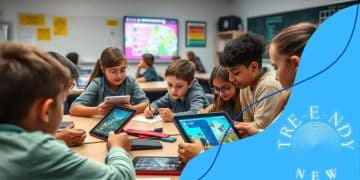Virtual labs for STEM education: revolutionizing learning

Virtual labs for STEM education provide accessible, engaging, and interactive learning experiences, allowing students to explore scientific concepts safely and effectively without geographical or resource limitations.
Virtual labs for STEM education are changing the way students engage with science and technology. Have you ever wondered how immersive simulations can make complex subjects easier to grasp? In this article, we’ll dive into the advantages and practical applications of these innovative learning tools.
Understanding virtual labs
Understanding virtual labs is essential for anyone interested in education, especially in the fields of science, technology, engineering, and math (STEM). These innovative tools simulate real-life lab experiences digitally, allowing students to perform experiments and explore concepts without the limitations of traditional settings.
With virtual labs, students can experiment in a safe environment, making mistakes without the consequences found in a physical lab. They can explore various scenarios and even repeat experiments to enhance their understanding. This flexibility is crucial in STEM education.
What Are Virtual Labs?
Virtual labs are online platforms or software that mimic real laboratory experiments using computer simulations. They provide a realistic experience and often include interactive elements to engage students better.
Key Benefits of Virtual Labs
- Access to diverse experiments: Students can engage in experiments that may be difficult to conduct in a typical classroom due to resource constraints.
- Safety and risk management: Virtual labs eliminate safety concerns, allowing students to make mistakes and learn from them.
- Flexibility: Learning can happen anytime and anywhere, enabling students to learn at their own pace.
Moreover, virtual labs can accommodate various learning styles. Students who benefit from visual learning will find simulations especially helpful in grasping complex concepts. By allowing individuals to experiment in a pressure-free environment, these labs promote curiosity and deeper understanding.
The integration of virtual labs into STEM curricula can lead to improved student engagement and performance. Teachers are also seeing positive results, as these tools enable them to create customized learning experiences while tracking student progress. With continuous advancements in technology, the potential for virtual labs to transform education is significant.
Benefits of virtual labs in STEM
The benefits of virtual labs in STEM education are vast and impactful. These platforms not only enhance learning experiences but also make science and technology more accessible to students from various backgrounds.
One key advantage of virtual labs is the ability to conduct experiments that may be too dangerous or expensive to perform in a traditional lab setting. This opens up opportunities for students to explore complex concepts without the fear of accidents or high costs.
Engagement and Interaction
Students often find learning in virtual labs more engaging. The interactive nature of these platforms encourages active participation, which can lead to better retention of knowledge. By immersing students in realistic simulations, they can see the consequences of their actions in real-time.
Catering to Diverse Learning Styles
- Visual learners benefit from the animations and graphics present in virtual labs.
- Kinesthetic learners can interact with digital tools, allowing for hands-on experience.
- Auditory learners can follow along with verbal instructions that accompany virtual experiments.
Furthermore, virtual labs provide flexibility that accommodates different schedules and learning paces. Students can revisit experiments and learn independently, which is especially helpful for those who may need more time to grasp material. This self-paced learning helps build confidence and master complex topics over time.
In addition, the analytical data provided by virtual labs allows both students and teachers to gain insights into performance. By assessing how students approach different scenarios, educators can tailor instruction and offer targeted support where needed. The feedback is immediate, helping learners understand their mistakes and correct them promptly.
How to implement virtual labs effectively

Implementing virtual labs effectively requires careful planning and consideration of various factors that enhance the learning experience. By understanding these key aspects, educators can create a more engaging and productive environment for students.
First, selecting the right platform is crucial. There are many tools available, each with unique features and capabilities. Choosing a platform that aligns with educational goals will ensure a smooth integration of virtual labs into the curriculum.
Key Steps for Effective Implementation
Here are some essential steps to implement virtual labs successfully:
- Determine the objectives: Identify the specific skills and knowledge you want students to acquire.
- Train educators: Provide training for teachers to familiarize them with the tools and best practices of utilizing virtual labs.
- Integrate into the curriculum: Develop lesson plans that incorporate virtual labs naturally into the existing curriculum, ensuring alignment with key standards.
After choosing the right tools and preparing educators, it is important to create a structured approach to using virtual labs. A consistent framework allows students to understand how to navigate the platform and utilize its features effectively.
Fostering Collaboration
Encouraging collaboration among students is another important aspect. Assigning group projects that require collaboration in virtual labs can enhance teamwork skills while making learning more dynamic. When working in teams, students can exchange ideas and learn from each other, leading to a deeper understanding of concepts.
Additionally, regular feedback plays a vital role in the implementation process. Educators should continuously assess student engagement and performance, using data from virtual labs to identify areas for improvement. This feedback loop helps fine-tune both instruction and lab activities, ultimately leading to better learning outcomes.
Comparing virtual labs to traditional labs
Comparing virtual labs to traditional labs reveals significant differences that can impact the learning experience in STEM education. While both methods offer unique benefits, understanding their distinctions helps in choosing the best approach for students.
One of the most notable advantages of virtual labs is accessibility. With traditional labs, students often face limitations due to location, equipment availability, and safety concerns. In contrast, virtual labs can be accessed from anywhere, making it easier for students to explore experiments that may not be feasible in their physical classroom.
Cost and Resources
Another key factor is cost. Setting up and maintaining a traditional lab can be expensive, requiring materials, equipment, and facilities. On the other hand, virtual labs eliminate these costs, allowing schools to allocate funds to other areas. They often require only a computer and an internet connection.
Learning Environment
The learning environments in virtual labs and traditional labs also vary significantly. In a traditional lab, students often work directly with materials and instruments, which can enhance hands-on learning. However, virtual labs provide immersive simulations that can be just as effective in teaching complex concepts. They offer experiments that are safer, allowing students to learn from mistakes without real-world consequences.
Moreover, virtual labs often come with built-in analytics that track student progress, an aspect that can be harder to achieve in traditional settings. This data helps educators assess understanding and adjust teaching methods accordingly.
Finally, it is crucial to recognize that both virtual labs and traditional labs can coexist in a well-rounded STEM curriculum. Each offers valuable experiences that can prepare students for real-world challenges. The key is to blend the strengths of both approaches to maximize learning.
Future trends in virtual STEM education
Future trends in virtual STEM education are shaping how students learn and engage with science, technology, engineering, and math. The rapid advancements in technology promise exciting changes that could improve educational outcomes significantly.
One major trend is the integration of artificial intelligence (AI) into virtual labs. AI can personalize learning experiences by analyzing student performance and adapting lessons to meet their needs. This customization helps in addressing diverse learning styles, ensuring that each student receives the support they require.
Enhanced Simulations
Another trend involves creating more immersive and realistic simulations. Virtual reality (VR) and augmented reality (AR) technologies are expected to play a significant role in virtual STEM education. Students will be able to conduct experiments in lifelike environments, making learning experiences feel more genuine and engaging.
Collaboration and Global Access
Collaboration tools will also become increasingly important. Platforms that allow students from different parts of the world to work together on projects can enhance cultural exchange and teamwork skills. This global access means that students can attend virtual labs without the limitations of geographical barriers.
- Gamification will be utilized to make learning more engaging.
- More focus on data analytics to improve educational strategies.
- Cloud computing will make resources more accessible to students and teachers.
Additionally, the emphasis on practical skills will grow. Schools will focus on problem-solving and creative thinking, encouraging students to apply what they learn in real-world scenarios. By utilizing project-based learning in virtual labs, educators can prepare students for the challenges they will face in the workforce.
As technology continues to evolve, virtual STEM education will adapt, incorporating new tools and techniques to enhance student learning and engagement. Staying updated with these trends will be essential for educators aiming to provide the best possible education.
In conclusion, embracing virtual labs in STEM education opens up a world of opportunities for both students and educators. These innovative tools not only provide safe and flexible learning environments but also cater to diverse learning styles, making science accessible to all. As technology evolves, so will the possibilities for enhancing education through virtual labs and online collaboration. By integrating new technologies and practices, we can prepare students for an ever-changing future, fostering curiosity and a love for learning in the fields of science, technology, engineering, and mathematics.
FAQ – Frequently Asked Questions about Virtual Labs in STEM Education
What are virtual labs?
Virtual labs are online platforms that simulate real laboratory experiments, allowing students to explore science and technology safely and interactively.
What are the benefits of using virtual labs?
Virtual labs enhance accessibility, reduce costs, and provide safe environments for experimentation, accommodating different learning styles.
How can educators implement virtual labs effectively?
Educators can implement virtual labs by selecting the right platforms, training staff, and integrating these tools into existing curricula.
What is the future of virtual STEM education?
The future includes advancements like AI personalization, enhanced simulations with VR/AR, and improved global collaboration among students.





